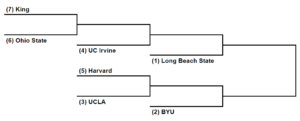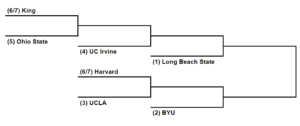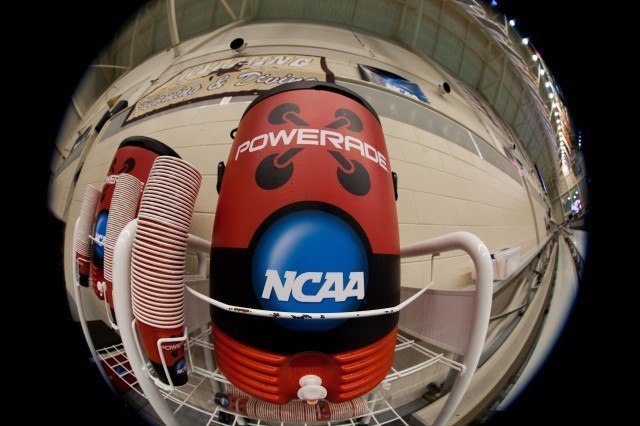The NCAA Tournament field is out with the seven teams knowing exactly who they will play, when it will be and where. There were some odd decisions this year while a few other spots were mostly expected. Let’s dive into a breakdown of some of those expected slots as well as some of the head-scratchers:
UC Irvine Edges Out Hawaii:
The big news of the day was that Hawaii was surprisingly left out with UC Irvine taking their spot as the second at-large team in the field. Here at VolleyMob, we had projected that the Rainbow Warriors made it in. After all, the two were very close in a few different aspects, so it seemed like Hawaii’s win earlier this week on a neutral court against UC Irvine to win the season series 2-1 would be the difference. Instead, the committee chose the Anteaters, so let’s take a look at the data that both teams had going their way.
UC Irvine (21-9, 6-4 Big West):
- 9-4 at home, 8-4 on the road, 4-1 on neutral
- Was not swept all season long
- Top Five Wins: vs. #2 BYU (3-1), vs. #2 BYU (3-2), at #4 Hawaii (3-1), (N) #7 Loyola Chicago (3-1), (N) #8 Lewis (3-0)
- Stronger depth of wins than Hawaii after each team’s best five victories
- Did not play Hawaii on their home floor this season
Hawaii (19-8, 6-4 Big West):
- 13-4 at home, 2-4 on the road, 4-0 on neutral
- Season series over UCI, 2-1
- Won most recent match on neutral floor (3-1)
- Only team to beat #1 LBSU this season
- Top Five Wins: vs. #1 LBSU (3-2), vs. #3 UCLA (3-1), (N) #5 UC Irvine (3-1), vs. #5 UC Irvine (3-1), vs. #8 Lewis (3-0)
- Was the #2 seed in the Big West Tournament (UC Irvine was #3)
- Therefore finished higher in regular and postseason in same league as UCI
So the top-notch wins are pretty much even down the board. UC Irvine does have better wins following that though, as they took down CSUN twice and won at Pepperdine versus wins at UC Santa Barbara and two over Concordia Irvine for Hawaii. So that slightly favors UC Irvine. The conference stuff favoring Hawaii though and being the only team to take out the 49ers evens the conversation.
Then you have the fact that Hawaii won the most recent on a neutral floor and the series 2-1 and it seems Hawaii should have the advantage. It’s also important to point out that last week in the RPI, UC Irvine was #4 and Hawaii was #5. After last week’s results though it seems likely Hawaii would be higher in the RPI.
However, it appears that the NCAA Tournament committee really valued road performance. Both teams had the same amount of losses at home, and almost identical records on neutral court. UC Irvine had the advantage of being able to drive up and down California though to face road matches just an hour or two’s drive from Anaheim, whereas Hawaii has to uproot their schedule to go on the road. That led to just six road matches and a poor 2-4 record with three coming in a row on a bad stretch at CSUN (twice) and Pepperdine. UC Irvine meanwhile took care of business away from home at 8-4.
It does seem a bit one sided for that to be a huge deciding factor, especially since the NCAA Tournament comes on neutral site (except for UCLA) as opposed to ones on the road. Nonetheless, the committee valued the Anteaters ability to schedule road matches and show success, which was likely the difference in their eyes.
Ohio State Pushed Behind Harvard for Play-In-Game:
From a resume standpoint, this might be the most puzzling choice in recent history. Let’s just take a quick view of what both team’s had to offer:
Ohio State (23-5, 11-3 MIVA):
- Won the MIVA Regular & Post-Season
- MIVA considered a more difficult league than the EIVA
- Top Five Wins: vs. #7 Loyola Chicago (3-0), vs. #7 Loyola Chicago (3-1), vs. #8 Lewis (3-0), vs. #8 Lewis (3-2), vs. #10 Ball State (3-2)
- RPI Headed Into Last Week: 7
Harvard (13-13, 10-4 EIVA):
- Won the EIVA Post-Season
- Finished tied for second (#3 seed) in regular season
- Top Five Wins: (N) #18 Penn State (3-2), vs. #18 Penn State (3-2), at (RV) Princeton (3-0), (N) (RV) Princeton (3-1), vs. (RV) Princeton (3-2)
- RPI Headed Into Last Week: 22
We have a more in-depth piece about this decision from the NCAA, called “Two-Time Defending Champions Ohio State Pushed to Play-In-Game”. Essentially it details the fact that despite Ohio State being the clear-better team, the NCAA chose to put them in the play-in-game instead of Harvard because the distance between the teams and the NCAA likely wanted to save money on travel. For instance, Ohio State and King are under 400 miles apart while King to Harvard is over 800 miles and Harvard to Ohio State is well over 700 miles.
That means this choice was likely all about geography/money, which is unfortunate for King as well, who would have owned a better chance to win their first NCAA Tournament match if it was Harvard. This concept isn’t new, as it happens all of the time in other sports. But what makes this one worse/different is the fact that having a team play closer to home in a 64-team field is minimized because everyone starts with the same amount of matches to play and no byes occur. In this event, pushing someone down to the play-in-game means Ohio State has to play an extra match to win an NCAA title than Harvard would, which is clearly not fair. Nonetheless, the NCAA opted for the lesser travel expenses.
The Expected:
Long Beach State as #1 was the most obvious choice while BYU downing UCLA to win the MPSF regular and postseason titles made them an easy choice for #2 as well. UCLA was projected as #3 and it was likely that the second at-large would be out of the play-in-game as well. It also seemed like King was destined for the play-in-game.
Other Note:
It seems that the NCAA Tournament has done away with seeding/ranking any teams outside of the top two – the ones who get a bye to the Final Four. LBSU was #1 and BYU was #2, but there was no tag of seeding next to any of the other teams. Bracket wise it would make sense that #3 would face the play-in-winner (essentially either #6 or #7). That winner would take on #2 while #4 takes on #5 to advance and meet #1. It doesn’t seem like those seeds exist, or at least they’ve been bent.
For instance, if that was the case in the bracket, that would mean UCLA is the #3 (which would be very likely). It would also mean that they should be taking on their play-in-opponent. And if we assume that you’re in the play-in-match because you are the #6 and #7 seed, that would make Harvard the #5. So therefore the bracket would be like this based on seeding:

However, if we are to assume what we said about the Ohio State/Harvard dilemma – in that Ohio State was only pushed down to the play-in-game for geographical reasons even though the Buckeyes should be the higher seed, this could also be the bracket if numbers were put next to everyone:


Leave a Reply